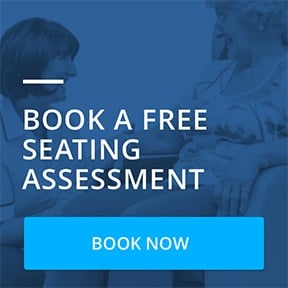Pressure mapping is a technology that has been in use for more than 30 years, and over that time the technology has evolved so that now it is as easy to use routinely as measuring blood pressure. And, like the latter, the technology provides clinical information that cannot normally be accessed without the technology.*
As the technology has advanced, mats have become more flexible (more easily following the contours of the body), able to provide data in real time (reflecting that sitting is a dynamic activity), able to transmit data wirelessly (allowing remote monitoring – even across the internet), and costs have come down (what cost £12000 10 years ago, costs as low as £2000 now).
What can we use pressure mapping for?
One can indeed use pressure mapping to view how one cushion compares with another in dispersing the forces applied by the seated person – but please do so with the user carrying out the activities they would normally do, and not in an artificial 90-90-90 position (in which no-one normally sits). Also bear in mind that the picture will change with time as the cushions adapts to the user, and the user’s tissues adapt to the cushion. However, pressure mapping has wider applications.
A valuable use of pressure mapping is to visualise whither the pressure has been redistributed as a consequence of seat and positioning adjustments. Back in the ‘90s, Professor Ian Swain reported that the simplest way to get better pressure redistribution of pressures away from the boney parts of the pelvis (the ITs), was to adjust the foot position (through the height of the foot supports) to have more pressure distributed under the thighs. Pressure mapping allows you to see the optimum set up of the different parts of the chair – foot supports, arm supports, back support, etc – for optimal pressure redistribution. (Note: The iShear product, in combination with pressure mapping, can be used to provide further information as to the distribution of forces arising from different positions of the individual.)
Pressure mapping is a great educational tool for use with carers and users. It’s a great way of showing in colour what the effects are of good vs poor positioning. It’s a great tool to show a user how far forward the user needs to lean to offload their ITs (see Figure 1)
In recent years, the greater impact of shear strain, rather than pressure alone, on tissue integrity has become appreciated. Using the ‘gradient’ view that pressure mapping systems offer, allows one to visualise where the greatest rate of change of pressure is occurring: the greater the pressure gradient, the greater is likely to be the distortion of the skin tissues. In figure 2, the left hand picture is the pressure map, and the right hand picture the pressure gradient map for the same reading. The latter shows higher gradients around the tail bone – an area of thin skin tissues and poorer blood supply – indicating where seating intervention would be most beneficial.
 Figure 2. Pressure vs pressure gradient views
Figure 2. Pressure vs pressure gradient views
And how does a pressure mapping system pay for itself?
Apart from the benefits around clinical outcomes, pressure mapping has financial benefits. Often a lower cost solution can be shown to be as effective as a requested higher cost item. Documentation of the effects of different solutions assessed in clinic, and the justification based on these assessments, cover the clinician and their employer where the user later prosecutes for clinical malpractice based on the solutions provided.
For further advice around pressure mapping, visit the PMG’s Best Practice Guidelines pages:
https://www.pmguk.co.uk/resources/best-practice-guidelines-bpgs/best-practice-guidelines
Haar, D. (n.d.). Myth: Pressure mapping is only used to compare cushions. Retrieved July 31, 2020, from http://www.besrehab.net/news-articles/myth-pressure-mapping-is-only-used-to-compare-cushions/
*Note - the purpose of this blog is to give an overview of the product with some tips to consider on its use. This is not intended to be a substitute for professional or medical advice, diagnosis, prescription or treatment and does not constitute medical or other professional advice. For advice with your personal health or that of someone in your care, consult your doctor or appropriate medical professional.




